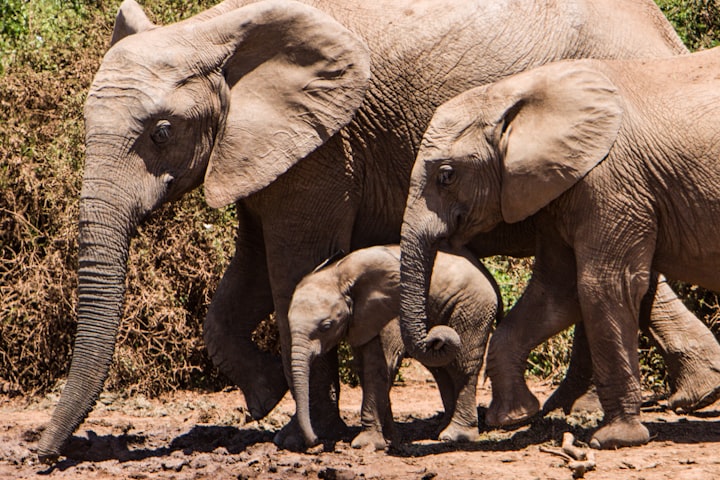Do elephants sneeze? Why don't elephants jump?
Elephants can sneeze, but not jump

Sneezing is a very cute act, and a YouTube video of a baby panda sneezing has received 217 million views. So we can't help but ask, "Do elephants sneeze? How do they do it?"
An elephant's trunk has multiple functions and can be used to smell, touch, carry, breathe and...sneeze!
John Lenhardt from the National Center for Elephant Conservation in Florida said in an email, "Elephants sneeze through their trunks. It's normal for elephants to sneeze very loudly and with spittle, it just changes to elephant specs."
Sometimes it looks cute.
Liquid eruption
Bill Milsom, a physiologist from the University of British Columbia, says mammals cough and sneeze by the throat and nasal passages, respectively. For elephants, the nasal snot has a long passage to pass through. He says, "Coughing and sneezing are both about clearing the air from the lungs and removing the source of irritation."
In both elephant and human trunks, foreign objects that irritate can enter from both ends and foreign irritants or irritants enter through the throat.
"As we eat, food can enter the nasal cavity," he said.
He added that mammals are the only creatures that chew their food in the mouth. Other animals, like reptiles, swallow their food whole or pause to breathe while chewing.
Other animals sneeze
Terrestrial animals are not the only creatures that have the urge to sneeze
Marine iguanas clear salt by sneezing through their nasal glands, Milsom said. Whales and dolphins drain water from their nasal passages before breathing, a process similar to sneezing.
He added that fish also remove particulate matter from their gills by coughing or sneezing.
Insect physiologist Allen Gibbs of the University of Nevada, Las Vegas, said in an e-mail that insects are not part of the sneezing club. Invertebrates can clear the air from their respiratory systems, but it's not clear if this is the same as our sneezing.
Elephants can run, but they don't jump.

Elephants have many enviable abilities: they have an excellent sense of smell, rarely get cancer, and have complex social lives. But, perhaps not surprisingly, one thing is that they cannot jump.
It's hard to say why this is so, mainly because no scientist has yet specifically studied why elephants can't jump up. It's likely because the animals are too heavy, while their relatively weak leg muscles and less flexible ankles also bear part of the blame.
John Hutchinson, professor of evolutionary biomechanics at the Royal Veterinary College in London, said, "Animals that want to make jumps need very flexible ankles, very strong tendons, and strong enough calf muscles, and elephants' calf muscles are very wintry and their ankles aren't very flexible."
Studying elephant locomotion has been an important part of Hutchinson's life, and his and colleagues' research on elephants was published in 2010 in the Proceedings of the National Academy of Sciences. The study points out that elephants are very good at long walks but rarely run, even when necessary, only for short distances, probably because they run with very poor endurance.
Hutchinson also observed that adult elephants and baby elephants do not have stagnation time when they run. This means that they always have one foot in contact with the ground while in motion.
Rhinos have lag time when they run.
Hutchinson's research shows that, in contrast to other large animals running when there will be lag time, such as the same large size of rhinoceros running up there. And it's not clear why this difference occurs. It is likely that the rhinoceros in the motor ability of the relevant functions than the elephant to develop caused.
Hutchinson said: "On the other hand, elephants do not try to jump around like kangaroos the most likely explanation is that they are such large beasts that once tripped in the jump, then the consequences can be very serious, or even lead to their paralysis. In addition, most animals usually jump to escape, elephants rarely encounter the need to escape the situation. For example, smaller, more agile animals will use their speed, agility, and bouncing power to escape predators, while the elephant's enormous size itself is already the best defense against them." He added that it is difficult to say specifically why elephants do not jump because scientists can not be falsified.
Perhaps the elephants decided on their own that they didn't want to jump around, and they may be shy on the matter.
No matter what you see in cartoons, a video from the Smithsonian Institution shows that elephants do not, in fact, jump. And here's a simple reason: they don't have to jump either.
Most animals that do jump, such as kangaroos, monkeys, and frogs, do so primarily to escape predators. Elephants can keep themselves safe in other ways, and they rely heavily on their large, protective herds. It is difficult to topple a 4-ton mammal to the ground in one go. For elephants, this is almost impossible to do. Unlike most mammals, all the bones in an elephant's legs point downward, which means they have no "springs" to jump up from the ground.
About the Creator
Flagler Danzig
The talent is 1% inspiration adds on 99% sweat, certainly, does not have that 1% inspiration, in the world all sweat to put or bring together also only is the sweat!






Comments (1)
Wonderful writing